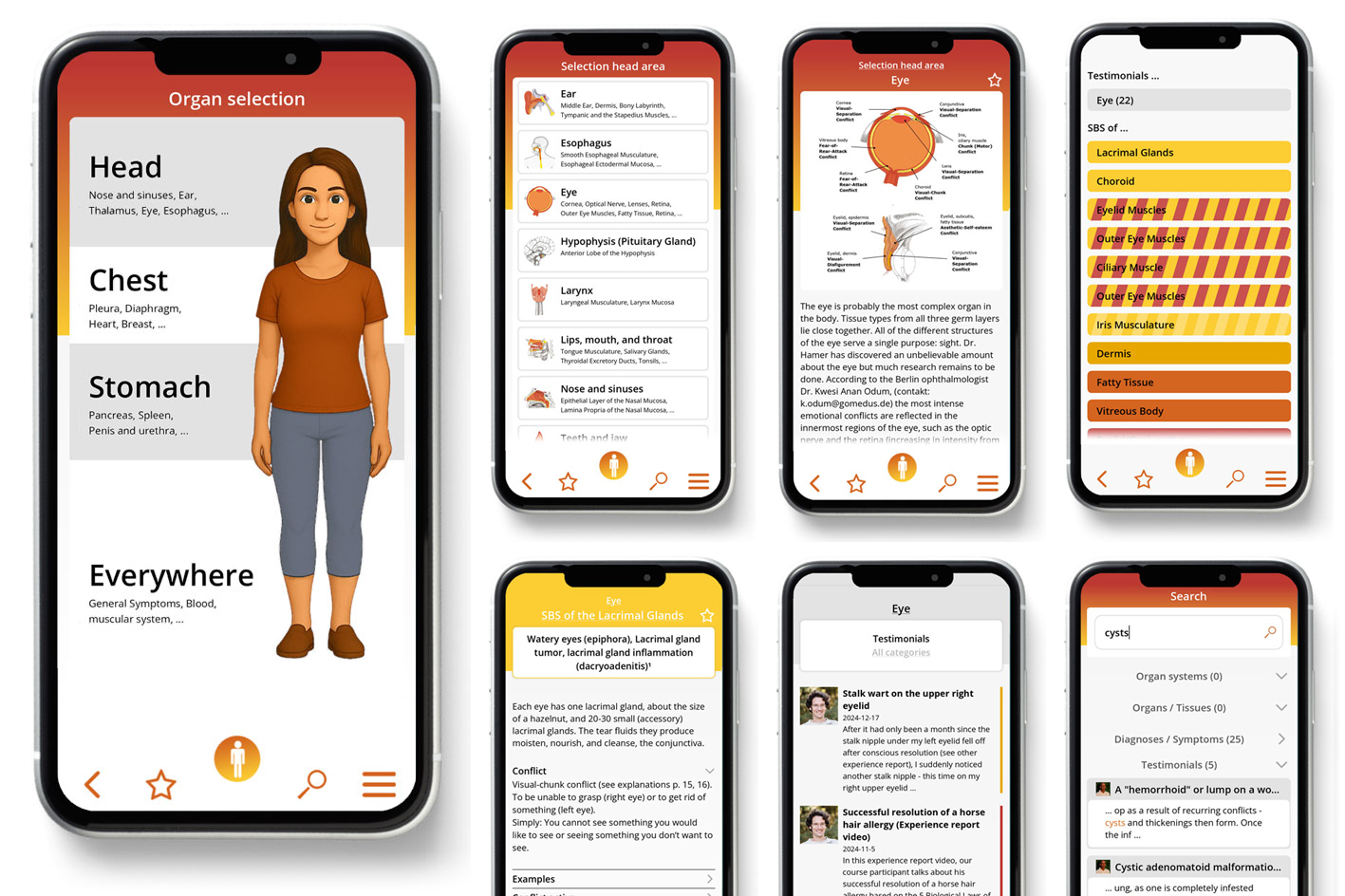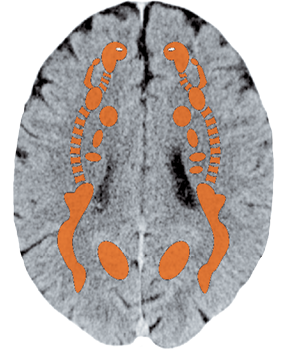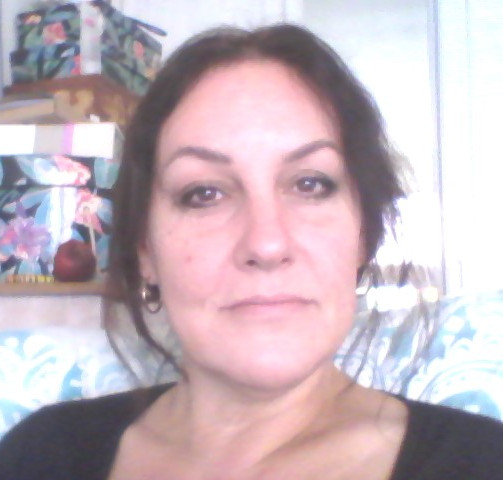 The information on this site is from one of the most famous books about the New Medicine (GNM / 5BN): "The Psychic Roots of Diseases" by Björn Eybl. Since September 2025, it is available in the form of an app with many additional features.
The information on this site is from one of the most famous books about the New Medicine (GNM / 5BN): "The Psychic Roots of Diseases" by Björn Eybl. Since September 2025, it is available in the form of an app with many additional features.It was written in german and was translated into more than 10 languages already. German is not freely available, as the rights are held by a publisher, but all these translations are available as ebooks / PDFs for free, as a gift of Björn for you, for the New Earth, for a new time.
In cooperation with Björn, it is splitted on "Disease is Different" into the sections by organ systems and combined with the real cases of our international testimonial / report archive of the related organ system.
SPLEEN
The fist-sized spleen lies on the left side of the body underneath the diaphragm. For a long time, the spleen’s function was not understood, as its removal seemed to have no physical effects worth mentioning. Today, we know its main purpose: the removal of old or damaged blood cells (via filtering and “devouring“ = phagocytosis) as well as the storage of blood cells, especially thrombocytes for bleeding emergencies.
CM agrees with Dr. Hamer in that the spleen belongs to the lymphatic system and that it is, in principle, a large — although blood perfused — lymph node. The lymph system and the spleen are entirely made up of mesodermal tissue.
A healthy human being has a thrombocyte count of between 150,000 and 350,000 per liter.
Red Pulp:
Self-esteem conflict
with regard to the blood.
White Pulp:
Self-esteem conflict,
not being able to remove
or clean something.


Spleen enlargement (splenomegalia), inflammation of the spleen
(splenitis), splenic abscesses, splenic cysts
| Conflict | 1. Red Pulp: Self-esteem conflict in regards to the blood 2. White Pulp: Self-esteem conflict, for not being able to remove or clean something |
|---|---|
| Examples | ➜ A human or animal is wounded or is bleeding = self-bleeding conflict. ➜ Someone gets a “blood cancer“ diagnosis or a blood transfusion. = Self-esteem conflict in relation to the blood.  A young woman has, because of an intestinal SBS lasting 5 weeks, large amounts of blood in the stool. = Self-bleeding conflict. Platelet count declines at this time to less than 5000 = active-phase. In the repair phase, the spleen swells. (Archive B. Eybl) A young woman has, because of an intestinal SBS lasting 5 weeks, large amounts of blood in the stool. = Self-bleeding conflict. Platelet count declines at this time to less than 5000 = active-phase. In the repair phase, the spleen swells. (Archive B. Eybl) A very health-conscious woman has a complete blood count done. The blood lipids are increased. Fearful, she goes back to the doctor and wants to determine the values again and again. > “Something is wrong with the blood.“ = Self-esteem conflict in relation to the blood. (Archive B. Eybl) A very health-conscious woman has a complete blood count done. The blood lipids are increased. Fearful, she goes back to the doctor and wants to determine the values again and again. > “Something is wrong with the blood.“ = Self-esteem conflict in relation to the blood. (Archive B. Eybl) The 28-year-old student is almost finished with his studies, only his thesis remains. Although the subject is fixed, he writes nothing for several months. “I should already be done with it, but I do not know where to begin.“ = Conflict, not being able to move something forward. Cannot “remove“ the thesis from his to-do list. Healing comes when he finally overcomes the writer‘s block and completes the first pages > cell division in lymph nodes and spleen (white pulp). CM finding: “Numerous consistently pathological lymph nodes to 4 cm in diameter…the spleen with a longitudinal diameter of 14, 5 cm, is well above the norm…massive generalized lymphadenopathy.” The patient knows the 5 Biological Laws of Nature, and can deal calmly with the diagnosis. By themselves, after the conflict resolution, the lymph nodes decrease by half their size. (Archive B. Eybl) The 28-year-old student is almost finished with his studies, only his thesis remains. Although the subject is fixed, he writes nothing for several months. “I should already be done with it, but I do not know where to begin.“ = Conflict, not being able to move something forward. Cannot “remove“ the thesis from his to-do list. Healing comes when he finally overcomes the writer‘s block and completes the first pages > cell division in lymph nodes and spleen (white pulp). CM finding: “Numerous consistently pathological lymph nodes to 4 cm in diameter…the spleen with a longitudinal diameter of 14, 5 cm, is well above the norm…massive generalized lymphadenopathy.” The patient knows the 5 Biological Laws of Nature, and can deal calmly with the diagnosis. By themselves, after the conflict resolution, the lymph nodes decrease by half their size. (Archive B. Eybl) |
| Conflict-active | In the first place: Necrosis of the spleen tissue — empty spaces are created for storing blood cells. The number of blood platelets (thrombocytes) in the circulating blood sinks; they are “captured“ and “stored“ in these empty spaces. In the area of the injury, however, the thrombocytes assure fast blood coagulation. Secondly: cell degradation in the white pulp (spleen necrosis) — holes like “Swiss cheese.” Only if the conflict was felt as generalized is the spleen affected — otherwise, only the lymph nodes react in the affected area (see: p.180). The active-phase is mostly unnoticed — no pain. |
| Repair phase | Increased metabolism, cell division = inflammation of the spleen (splenitis). This causes the spleen to swell up (splenomegalia). Afterwards, the spleen remains enlarged A splenic abscess may occur during the repair phase through a recurring-conflict. Splenic cysts indicate a completed SBS or a recurring process. |
| Bio. function | At the end of the repair phase, the spleen is larger than before. > 1. This leads to better blood storage capacity and filter capacity. > From that point onwards, the body will be better able to deal with heavy bleeding and, in case of poisoning for instance, the body can remove more damaged blood cells from circulation. 2. Improved lymph node capacity. |
| Questions | 1: Determine the phase: Blood count? (Thrombocytes increased/decreased)? Inflammation, pain? (> Repair phase). Which event brought on the repair phase? Splenic cysts: Have I ever experienced severe bleeding? Did I ever sympathise with someone who was bleeding/bled to death? Am I reading much too much into my blood count? Can I deal well with accidents? Were there dramatic bleeding incidents with my ancestors that have conditioned me? Dreams? 2: Enlarged lymph nodes in the body? Yes > What am I not able to remove? (Tumor, problem)? |
| Therapy | For inflammation of the spleen or an abscess, the conflict is resolved. > Support the repair phase. Lymph drainage massages (see p. 68). Spleen compresses: wrap the abdomen in a warm, damp cloth with a dry cloth over it and go to bed (possibly soaked in salt water). Garlic/lemon drink cure. Tea: fenugreek, fennel seed, kidneywort, toadflax, deadnettle, absinthe. MMS (see p. 68). Hydrogen peroxide (H2O2 3% internally. |
All experience reports on the organ system «Spleen» from the International Report Archive:
| Author | Title and Overview | Keywords | ||||
|---|---|---|---|---|---|---|
 | 2025/10/21   Dramatic symptomatic improvement of a PCL phase of splenic SBS (splenic Ca) with EFT | Spleen, bleeding conflict |
